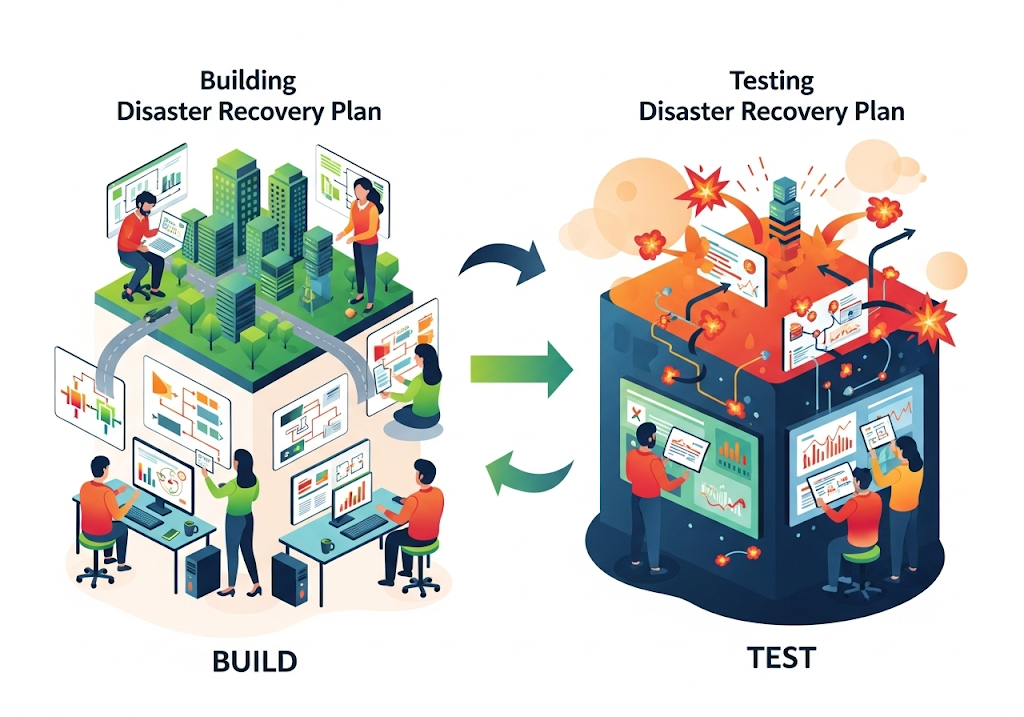
Building and Testing Disaster Recovery Plans for SaaS Applications
Building and Testing Disaster Recovery Plans for SaaS Applications
In today’s digital landscape, SaaS (Software as a Service) applications are the backbone of business operations- handling everything from communications and collaboration to customer management and critical process automation. Yet, the convenience of SaaS does not eliminate the risk of data loss, outages, or cyber disasters. In fact, with data and services now living “in the cloud,” organizations must take a proactive, disciplined approach to disaster recovery (DR) planning and testing– ensuring resilience, regulatory compliance, and rapid recovery when the unexpected happens.
This guide explores the advanced best practices for SaaS disaster recovery, moving beyond basic backups to cover architectural, operational, and strategic dimensions. Whether you are a SaaS consumer, administrator, or architect, this framework will help you build, test, and continuously improve a robust DR plan tailored to your SaaS environment.
Why Disaster Recovery for SaaS Is Different- and Critical
Unlike traditional on-premises software or even IaaS (Infrastructure as a Service), the responsibility for SaaS disaster recovery is shared between the SaaS provider and the end-user organization. The provider manages infrastructure, application uptime, and high-availability features, while the customer is responsible for protecting their own data, maintaining business-critical workflows, and ensuring continuity in the face of both provider-side and user-side failures.
Downtime or data loss in a SaaS application can have severe consequences: lost productivity, reputational damage, customer churn, and even legal penalties (especially for regulated data like PII, PHI, or financial records). Unlike physical infrastructure, SaaS platforms are vulnerable to a broad array of risks- cloud provider outages, cyberattacks, ransomware, accidental deletions, misconfigurations, and even vendor insolvency.
Key Risks for SaaS Consumers:
Provider outages: Even leading SaaS platforms can experience service disruptions, sometimes for hours or days.
Accidental or malicious deletions: End users can delete critical data- sometimes irrevocably if not backed up.
Ransomware and cyberattacks: SaaS data can be exfiltrated, encrypted, or corrupted by attackers.
Data export/import challenges: Migrating data out of a SaaS platform can be complex, slow, or impossible without vendor support.
Vendor lock-in: Your data may be trapped if a SaaS provider discontinues a product or goes out of business.
Given these risks, organizations cannot simply trust that their SaaS provider will take care of everything. You need a plan- and that plan must be regularly tested.
Defining Your Recovery Objectives: RPO and RTO
Before you build a DR plan, you must define your Recovery Point Objective (RPO)– how much data loss your business can tolerate- and your Recovery Time Objective (RTO)– how quickly systems and data must be restored after an incident.
RPO (Recovery Point Objective): For mission-critical SaaS applications, RPO might be near-zero (as little data loss as possible). For non-critical applications, RPO could be hours or even days.
RTO (Recovery Time Objective): Some business functions can tolerate downtime, while others require rapid restoration. For example, a sales CRM might have an RTO of minutes, while a non-core HR app might allow hours or days.
Both RPO and RTO must be set by business leaders- not IT alone. These objectives will drive your backup frequency, retention policies, failover procedures, and testing cadence.
Key Components of a SaaS Disaster Recovery Plan
A robust SaaS DR plan covers both technical and procedural elements:
1. Data Backup Ownership and Export
Never assume your SaaS provider’s backup is sufficient. Even major SaaS vendors may not offer point-in-time restore, granular recovery, or the retention your business needs. Conduct your own backups– regularly exporting business-critical data to secure, independent storage locations. Many SaaS platforms offer APIs, automated export tools, or integration with third-party backup solutions (such as Veeam, Zerto, Backupify, or Spanning). Test your restore process– can you recover exactly what you need, when you need it?
2. SLA Review and Business Impact Analysis
Read your SaaS provider’s SLA– cover recovery capabilities, uptime guarantees, and support response times. Conduct a business impact analysis– identify which SaaS apps are mission-critical, which can tolerate downtime, and what the real cost of an outage would be.
3. Compliance, Security, and Data Governance
Verify that your SaaS provider meets industry and regulatory requirements (GDPR, HIPAA, SOC2, etc.). Ensure data is encrypted in transit and at rest. Implement strong access controls and audit logging. Document where your data resides geographically– sometimes this matters for compliance.
4. Vendor Lock-In Avoidance and Exit Planning
Plan for the worst case: Could you extract your data and migrate to a new platform if your SaaS provider goes out of business or discontinues a product? Ensure you have a documented process and technical capability to export all critical data in a usable format.
5. Communication Plans and Incident Response
Define internal communication protocols for announcing, escalating, and resolving SaaS outages. Train staff on what to do if a critical SaaS app goes down- do you switch to a backup system? Use offline forms? Notify customers? Coordinate with your SaaS provider’s support to understand their escalation paths and transparency during incidents.
6. Redundancy and Alternative Access
For mission-critical SaaS apps, consider a backup provider– can you temporarily switch to a similar SaaS platform if your primary is down? Implement strong authentication and access controls– don’t let a breached SaaS account lock you out during a crisis.
7. Disaster Recovery Testing
Regularly test your DR plan– not just the technical restore, but the end-to-end workflow. Simulate provider outages, data loss, and cyberattacks. Run tabletop exercises with business stakeholders. Review and update your plan after every test and every major business change.
Advanced Techniques for SaaS DR Testing
Testing is where most SaaS DR plans fail. Organizations often assume their backups work, their exports are complete, and their staff knows what to do- only to discover gaps during a real crisis.
Comprehensive Test Scenarios
Data corruption or deletion: Simulate a user accidentally deleting a critical record- can you restore it from your backup?
Provider outage: Pretend your primary SaaS platform is unavailable- how long does it take to switch to a backup provider or restore from your export?
Ransomware or cyberattack: Test your ability to recover clean data if your SaaS account is compromised.
Mass data loss: Practice restoring your entire dataset- how long does it take? Does everything work as expected?
Tabletop Exercises
Bring together IT, security, compliance, and business leaders to walk through DR scenarios. Document lessons learned and update your DR plan accordingly.
Automated Validation
Use scripting and automation to validate backups- confirm that exports are complete, data is uncorrupted, and restores are possible. Integrate DR testing into your CI/CD pipeline for critical SaaS apps.
Continuous Improvement
After each test, review: What worked? What didn’t? Update your DR documentation, train staff, and refine your processes. Keep your DR plan aligned with business priorities– as your SaaS footprint grows, so should your DR maturity.
The SaaS Provider’s Role in Disaster Recovery
While this guide focuses on the consumer perspective, SaaS providers also have responsibilities- and their DR capabilities directly impact your risk.
Providers should:
Design for high availability, with multi-region, multi-zone redundancy.
Offer transparent SLAs that clearly state recovery capabilities and uptime guarantees.
Conduct regular DR tests and share results with customers.
Provide granular restore options– not just full backups, but the ability to recover individual records, files, or configurations.
Communicate clearly during incidents, with real-time status updates and actionable guidance for customers.
As a consumer, you should evaluate these capabilities when selecting a SaaS provider- and hold vendors accountable through contracts and regular reviews.
How Buxton Can Help
At Buxton, we help organizations design, implement, and test SaaS disaster recovery plans that go beyond the basics. Our approach combines technical expertise, risk management, and business alignment to ensure your SaaS applications are truly resilient.
Strategic Assessment
We conduct comprehensive reviews of your SaaS portfolio, identifying critical dependencies, single points of failure, and gaps in your DR preparedness. We help you define RPO and RTO based on real business impact, not guesswork.
Architecture and Automation
We design automated data export and backup workflows tailored to your SaaS platforms. We help you integrate third-party backup solutions where native options are insufficient, and we automate validation so you know your backups are always reliable.
Testing and Validation
We design and execute realistic DR tests– simulating outages, data loss, and cyber incidents. We run tabletop exercises with your leadership and IT teams, ensuring everyone knows their role in a crisis.
Continuous Improvement
We help you build a culture of resilience, embedding DR best practices into your daily operations. We provide ongoing reviews and updates as your SaaS environment and business needs evolve.
Vendor Management
We help you evaluate SaaS providers for DR maturity, negotiate stronger SLAs, and plan for vendor transitions if needed.
Compliance and Security
We ensure your SaaS DR strategy meets regulatory requirements and follows security best practices. We help you document compliance and prepare for audits.
With Buxton, you gain a partner who understands both the technical and business dimensions of SaaS disaster recovery. We help you move from reactive backups to a proactive, tested, and business-aligned DR program- reducing risk, protecting your data, and ensuring continuity when it matters most.
Conclusion
SaaS applications are here to stay- and so are the risks they bring. Organizations that treat SaaS DR as an afterthought expose themselves to unacceptable downtime, data loss, and compliance risk. By taking a proactive, disciplined, and continuously tested approach– covering data export, backup validation, incident response, and vendor management- you can achieve true resilience in the cloud.
Buxton is here to guide you on this journey. Let’s build a SaaS DR plan that works- not just on paper, but when it matters most.

